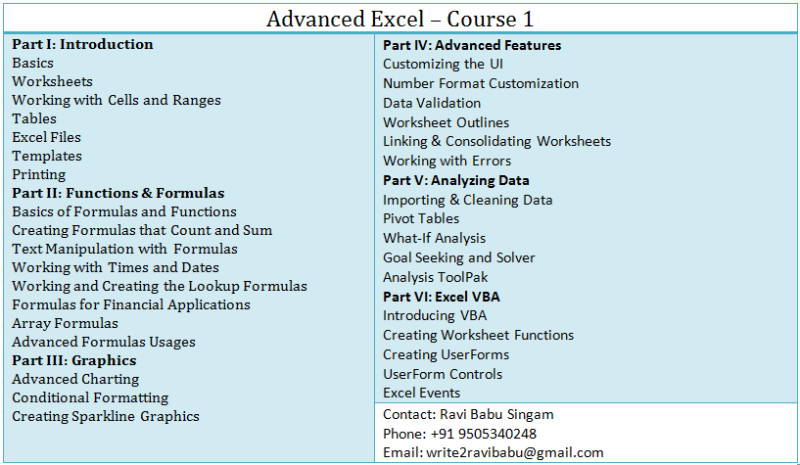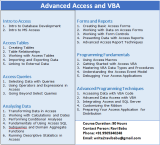Audience: Anybody with interest
What you learn?
You learn Python programming language and data analysis techniques.
Course Contents:
1.Why learn a programming language?
The motivation
Computer hardware architecture
Understanding programming
Why Python?
Interpreter and compiler
Whatâ??s a program?
Writing a program
The building blocks of programs
Debugging?
2.Variables, expressions, and statements
Values and types
Variables
Variable names and keywords
Statements
Operators and operands
Expressions
Order of operations
Modulus operator
String operations
Asking the user for input
Comments
Choosing mnemonic variable names
3.Conditional execution
Boolean expressions
Logical operators
Conditional execution
Alternative execution
Chained conditionals
Nested conditionals
Catching exceptions using try and except
Short-circuit evaluation of logical expressions
4.Functions
Function calls
Built-in functions
Type conversion functions
Random numbers
Math functions
Adding new functions
Definitions and uses
Flow of execution
Parameters and arguments
Fruitful functions and void functions
Why functions?
5.Iteration
Updating variables
The while statement
Infinite loops
â??Infinite loopsâ?? and break
Finishing iterations with continue
Definite loops using for
Loop patterns
Counting and summing loops
Maximum and minimum loops
6.Strings
A string is a sequence
Getting the length of a string using len
Traversal through a string with a loop
String slices
Strings are immutable
Looping and counting
The in operator
String comparison
string methods
Parsing strings
Format operator
7.Files
Persistence
Opening files
Text files and lines
Reading files
Searching through a file
Letting the user choose the file name
Using try, except, and open
Writing files
8. Lists
A list is a sequence
Lists are mutable
Traversing a list
List operations
List slices
List methods
Deleting elements
Lists and functions
Lists and strings
Parsing lines
Objects and values
Aliasing
List arguments
9.Dictionaries
Dictionary as a set of counters
Dictionaries and files
Looping and dictionaries
Advanced text parsing
10.Tuples
Tuples are immutable
Comparing tuples
Tuple assignment
Dictionaries and tuples
Multiple assignment with dictionaries
The most common words
Using tuples as keys in dictionaries
Sequences: strings, lists, and tuples
11.Regular expressions
Character matching in regular expressions
Extracting data using regular expressions
Combining searching and extracting
Escape character
12.Networked programs
HyperText Transport Protocol - HTTP
The Worldâ??s Simplest Web Browser
Retrieving an image over HTTP
Retrieving web pages with urllib
Parsing HTML and scraping the web
Parsing HTML using regular expressions
Parsing HTML using BeautifulSoup
Reading binary �les using urllib
13.Using Web Services
eXtensible Markup Language - XML
Parsing XML
Looping through nodes
JavaScript Object Notation - JSON
Parsing JSON
Application Programming Interfaces
Google geocoding web service
Security and API usage
14.Object-Oriented Programming
Managing Larger Programs
Getting Started
Using Objects
Starting with Programs
Subdividing a Problem - Encapsulation
Our First Python Object
Classes as Types
Object Lifecycle
Many Instances
Inheritance
15.Using databases and SQL
What is a database?
Database concepts
Database Browser for SQLite
Creating a database table
Structured Query Language summary
Spidering Twitter using a database
Basic data modeling
Programming with multiple tables
Constraints in database tables
Retrieve and/or insert a record
Storing the friend relationship
Three kinds of keys
Using JOIN to retrieve data
16.Visualizing data
Building a Google map from geocoded data
Visualizing networks and interconnections
Visualizing mail data












